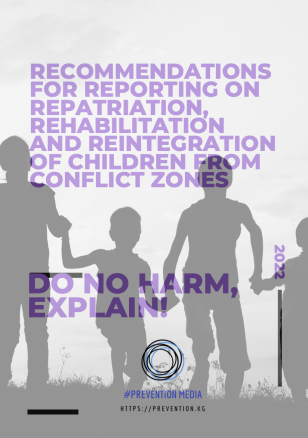Recommendations for reporting on repatriation, rehabilitation and reintegration of children from conflict zones
Recommendations for reporting on repatriation, rehabilitation and reintegration of children from conflict zones
July 22, 2022
In the period from 2018 to 2021, relatives of citizens of Kyrgyzstan who are in camps for internally displaced persons and refugees in Syria and prisons in Iraq repeatedly appealed to the official authorities of the Kyrgyz Republic to assist and organize the return of their relatives and friends from conflict zones [1].
Over the years, a large number of reports and materials on the conflict in the Middle East have been published in the Kyrgyz media. According to data from the State Committee for National Security of the Kyrgyz Republic for 2018, 850 Kyrgyzstanis left for the war zone in Syria until 2020, of whom 150 were killed there. It is noted that 140 more women are among those held in Syria [2].
While the media of Kazakhstan (Operation “Zhusan”) and Uzbekistan (Operation “Mehr”) [3], immediately after returning began to broadcast the details of the operations [4], then the media of Tajikistan [5] and Kyrgyzstan (Operation “Meerim”) [6], began broadcast limited information.
The return of people from conflict zones and camps for internally displaced persons and refugees causes mixed reactions in Kyrgyz society. On the one hand, there are relatives and loved ones of those who remain in Syria and Iraq, they are supported by human rights activists and some citizens who believe that children and women should be returned from conflict zones, while on the other hand there are opponents of return, as they doubt that returnees will be able to fully undergo social rehabilitation and are not a threat to society [7].
The repatriation of children affected by the actions of international terrorist organizations banned in most countries of the world, from areas where hostilities are taking place, causes acute controversy in society, which does not stop even after humanitarian operations carried out by governments [8].

 Locations
Locations





